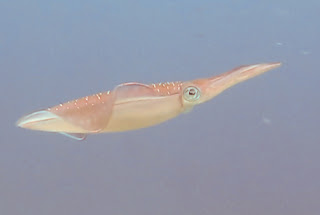Cyclops Dive Site seems to be where they have made their home this year and Divers who approach with care are often rewarded with fantastic shows of flambuoyancy and colours, as these large Cephalopods dance before you.
Like Sirens, you have to be a bit careful or they can very swiftly lead you off into the deep, especially if you are trying to get that perfect shot. Squid like to stay just outside the focal area of the cameras!
There are around 300 species of Squid that we know of but I am pretty sure these are the European Squid or "Loligo Vulgaris" to give the proper species name.
These squid are usually found at any depth between the surface and 500m but are most commonly seen around 20-250m. Here in Cyprus, they can be seen at the 15m sandy patch at the far end of the Dive Site.
Squid have the main part of their body enclosed inside the mantle. The Mantle Cavity contains the digestive and reproductive systems, gills and Siphon, which the squid uses for propulsion.
To enable movement, the Squid sucks water into the mantle cavilty and ejects it in a strong jet through the Siphon and the direction of the siphon can be changed to suit the direction of travel the squid wishes to go.
You will find a small swimming fin along the side of the squid's body but these are pretty redundant for locomotion, as the siphon is the primary means of movement.
Doctor Who has nothing on these elegant creatures who can also boast 3 hearts!!
Don't however, be fooled into thinking this makes them adorable, loving creatures, as alongside the 8 arms and 2 tentacles on the head, you will also find the Squid's Horny Beak, which it uses to kill and tear its prey into more manageable bite-size pieces.
They prey on other fish and crustaceans, which probably explains the masses of crab shells and broken crab legs we have been seeing recently around the Cape Greko area. Cannibalism is also not unheard of.
Squid beaks are often found undigested in the bellies of whales.
Eyes can be easily seen on the side of the Squid's head and, unlike the human eye, which changes the shape of the lens to focus, a squid's eye comprises a hard lens which can focus by changing the lens' position. Much like a camera or telescope.
The squid's flambuoyant colours come from Chromatophores that cover their body. These chromatophores allow the squid to change colour, enabling them to become almost invisible to prey and predators alike. On today's dive, our squids became almost translucent as a group of divers came swimming a little too close.





No comments:
Post a Comment